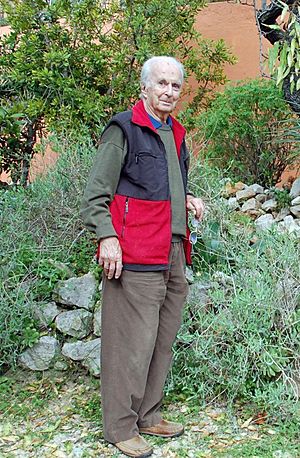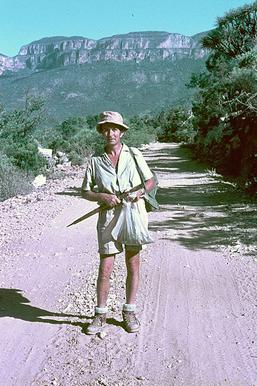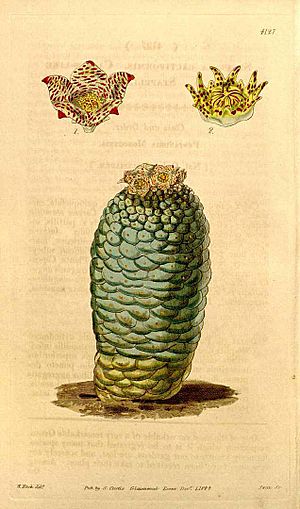John Jacob Lavranos facts for kids

John Jacob Lavranos (born March 29, 1926, in Corfu, Greece – died February 1, 2018, in Portugal) was a Greek-South African insurance broker. He was also a very important botanist, someone who studies plants. He especially loved and studied succulent plants, which are plants that store water in their leaves or stems. Lavranos discovered and described almost 300 new types of plants! Many plants have even been named after him to honor his work.
John's Early Life
John's mother, Lily, was part Swiss and German. She lived with her husband Philip in their family home in Chlomos, Corfu. They raised John and his younger brother, Max. They lived through World War II, when Corfu was occupied and bombed.
After the war, John served in the Greek Navy. He then studied economics and law at the University of Athens. He earned his degree in 1948. In September 1952, he moved to South Africa with his first wife, Helen. There, he began working as an insurance broker. Later, in 1967, he went back to school. He studied Natural Science at the University of South Africa. The next year, he started a master's degree in botany and geography at the University of the Witwatersrand.
Discovering New Plants
For over 50 years, John Lavranos traveled to many faraway places. He visited southern Arabia, Somalia, and Socotra. He also explored Kenya, Tanzania, Mozambique, and Madagascar. His travels included Reunion Island, Mauritius, the Canary Islands, and Greece. In his later years, he visited the southwestern United States, Mexico, and Chile. In South Africa, he explored areas like Namaqualand and the Richtersveld.
John discovered and described many new types of succulent plants. He worked with famous organizations like the National Museum of Natural History (France) and Kew Gardens. He also collaborated with the Jardin Exotique de Monaco and the Missouri Botanical Garden. His findings were often published in the 'Cactus & Succulent Journal'. He focused on plants like Asclepiadoideae, Pelargoniums, and Aloes. He collected about 32,000 pressed plant specimens. He described or helped describe about 180 different plant groups.
Later Life and Legacy
In 1995, John settled in Loulé, a city in southern Portugal. He gave most of his plant collection to the Gibraltar Botanic Gardens. He kept his love for plants alive. He often wrote to other botanists. He also made time to meet with people who loved succulents.
John Lavranos is remembered in the name of a plant group called Lavrania. Many plants are also named after him, like Aloe lavranosii and Eriospermum lavranosii. Aloe lavranosii comes from Yemen. It is special because it has hairy leaves and yellow-green flowers.
Some plants were named after his wives too. Crassula susannae was named for Suzanne Lavranos, his second wife. Caralluma mireillae was named after Mireille, his third wife. He met Mireille in Djibouti. She was very supportive of his plant explorations and often went with him.
John was known for being practical and precise. He was energetic and had a good sense of humor. He knew a lot about botany and geology. He also had great knowledge of weather, geography, astronomy, history, and music. He was a talented pianist when he was younger. He could speak many languages, including Greek, English, German, French, Italian, Spanish, Portuguese, Arabic, and Afrikaans. John Lavranos passed away in Loulé, Portugal after a stroke.
See also
 In Spanish: John Jacob Lavranos para niños
In Spanish: John Jacob Lavranos para niños



